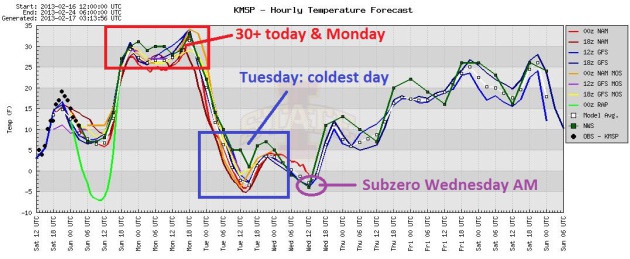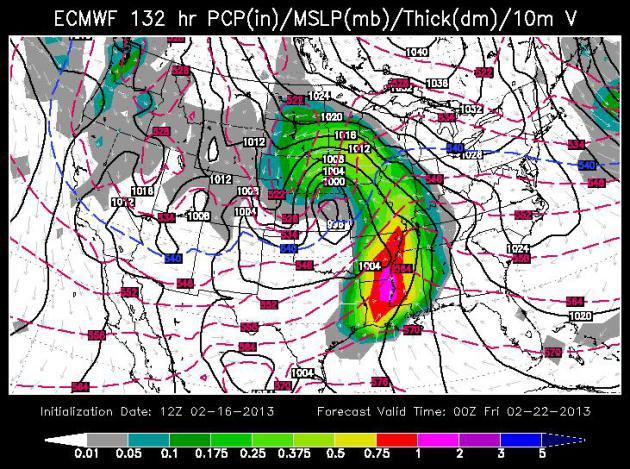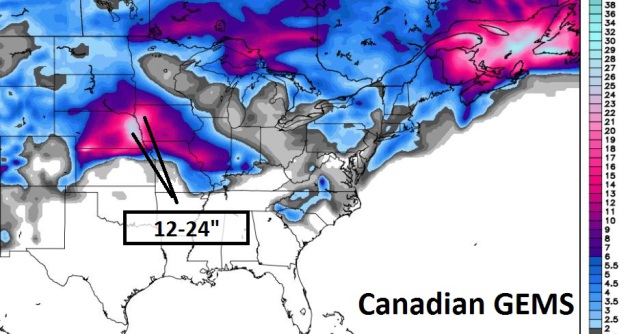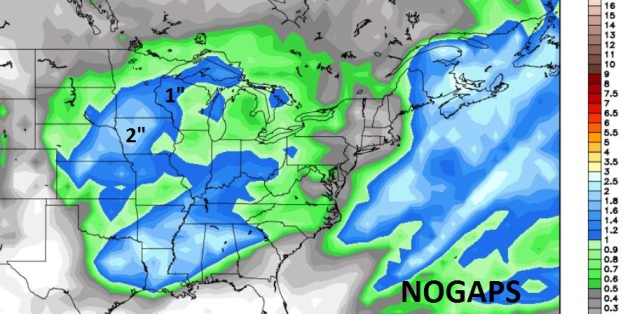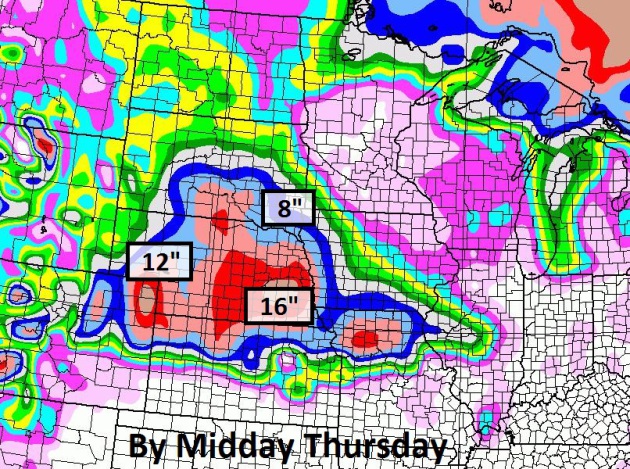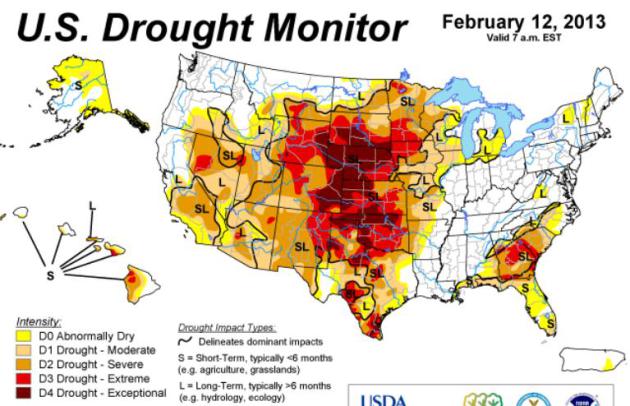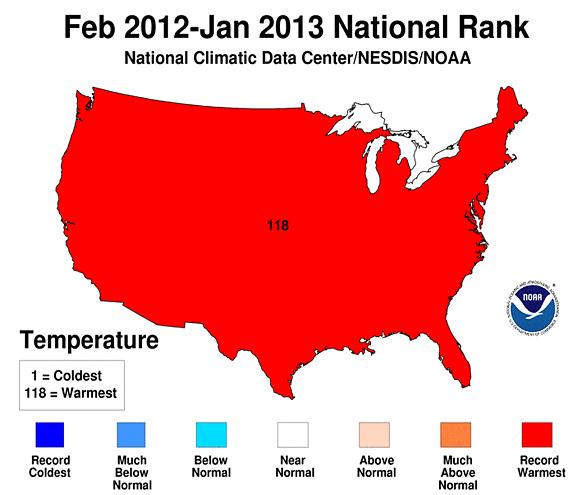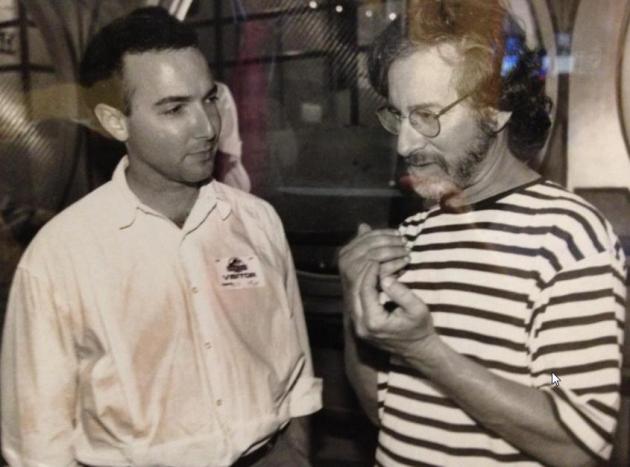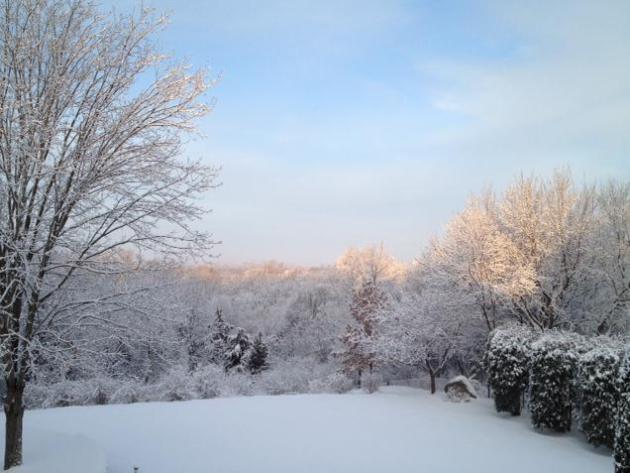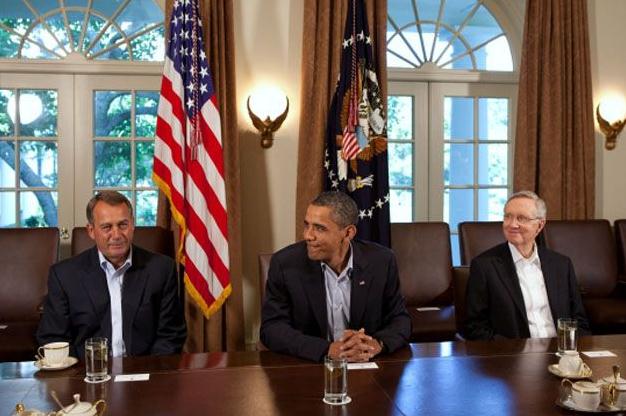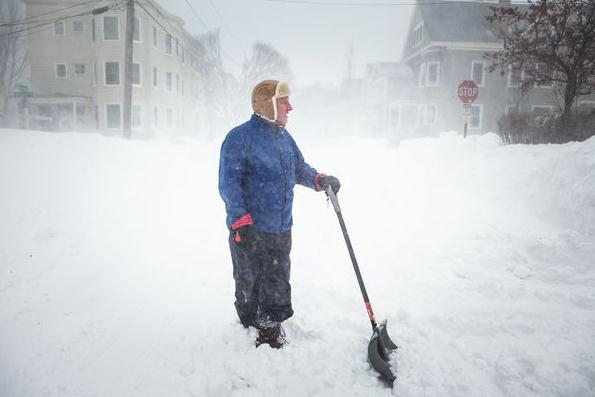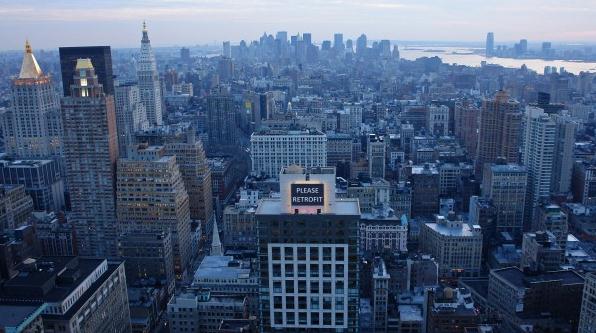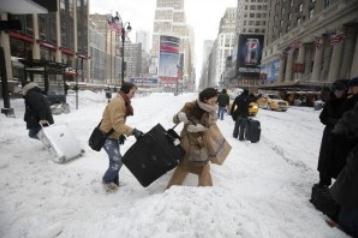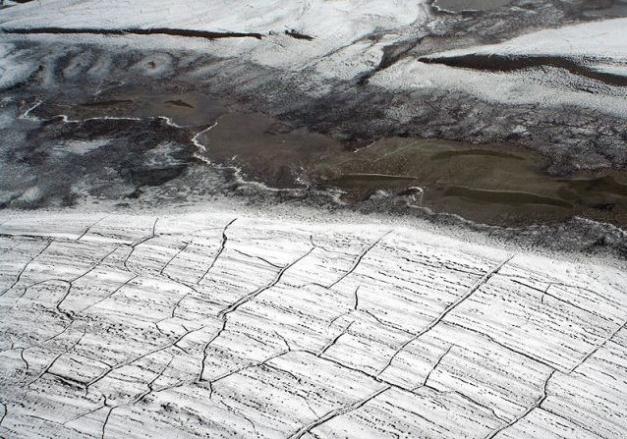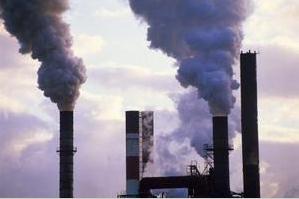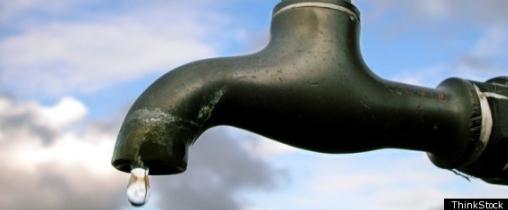Asteroid Angst?
It's hard to type - curled up in the fetal
position - in a weather bunker - 3 stories underground. Tornadoes,
hurricanes? No sweat. We can track them and warn you. But asteroids?
Blink of an eye. I have a few friends who freaked out Friday, but here's
good news from NASA: 90 percent of the (extinction-level) asteroids
have been discovered & tracked - no danger of a direct hit. Now,
about that other 10 percent. IF they can find them, with 10-20 years to
spare, we MAY be able to nudge them away from Earth in time! No worries.
We live with risk every day. The odds of
drowning in the tub or dying from a fall on ice are orders of magnitude
riskier than natural disasters, including asteroid strikes.
I know, that's what the dinosaurs thought too.
A significant snowfall requires 2 things: a deep
layer of cold air (to prevent a change to ice/rain) and a wet storm
tracking from the south. We may have both ingredients; a (very?)
plowable snowfall Thursday PM into Friday. I'm not quite mad enough to
predict how many inches, but it could be enough to placate frustrated
snow lovers.
So far in February at MSP: 10.6 inches of snow. A year ago we hadn't even picked up a half inch. Progress.
* asteroid poster above:
The Meta Picture.
After peaking
near 30 today and low to mid 30s Monday the mercury tumbles Monday
night, maybe holding in single digits Tuesday, the coldest day in sight.
One benefit (wrong word) of a fresh blast of Canadian air? A deep layer
of cold air necessary to insure all-snow as moisture returns from the
south by Thursday. Graph: Iowa State.
Classic Track For Significant Snow. The ECMWF model,
valid Thursday evening, shows a strong storm over eastern Kansas,
pushing northeast into Iowa Thursday night, pulling a vast swirl of
moisture from the Gulf of Mexico into the Mississippi Valley and
Midwest. Yes, it may snow (a lot).
Canadian Model. The GEMS shows a bulls-eye of well
over a foot of snow by Thursday evening as close as Omaha and western
Iowa. That shield of moderate/heavy snow may push into Minnesota
Thursday night into Friday morning.
NOGAPS Model. The Navy NOGAPS simulation shows over
an inch of (liquid) water from central Minnesota and western Wisconsin
southward to Kansas City, as much as 2" for Iowa and far southern
Minnesota, implying well over a foot of snow. We'll see. It's still
early. There is much that can go wrong with this storm (like all
others). That said, I'm pretty impressed.
NAM Model. The NAM goes out 84 hours, but shows well
over a foot of snow from southern South Dakota into Nebraska and
northern Kansas by lunchtime Thursday. Another data point.
Model Spread. The GFS model runs (the only ones that
go out that far) show some 5-10" snowfall potential Thursday PM into
midday Friday. Too early to gas up the snowblower, but I might brush the
cobwebs off.
Bufkit. GFS data, using the Bufkit method for snow
calculation, shows about 10" at MSP by Friday evening in the Twin
Cities. No, I'm not predicting 10", at least not yet. Just showing you
the calculus we go thru when trying to predict how many inches will
actully pile up.
Drought Update. I'm seeing some vaguely encouraging
signs on the weather maps that the edge may be coming off the drought.
The pattern is shifting (slightly), allowing more southern moisture
from the Gulf of Mexico to reach Minnesota. If (and it's a big if) this
trend continues the drought may gradually fade by late spring, at
least over the Upper Midwest. We won't know until March and April, if
the big (rains and snows) arrive, after most of the frost has left the
ground. Last winter at this time we had very little snow on the ground,
and we warmed up (dramatically) in March; record warmth with very
little moisture. The fact that it's persistently cold, and we're seeing
a greater frequency of storms, many pumping up moisture from the
south, is a good sign. We'll see. Here's an excerpt from this week's
edition of
Weather Talk, from Mark Seeley: "
Highlights
for the drought-monitoring period ending on February 12 from Brad
Rippey at the USDA World Agricultural Outlook Board include:
- Overall U.S. drought coverage decreased to 55.73% of the contiguous
U.S., down 1.11% from last week and down 5.36% since the beginning of
the year. The decrease came on the strength of heavy rain across the
South and some snow in the upper Midwest.
- The portion of the contiguous U.S. in the worst category D4, or
exceptional drought dipped nearly one-quarter of a percentage point
(0.24%) to 6.61%. D4 coverage has ranged from 5 to 7% for 27
consecutive weeks (August 14, 2012 February 12, 2013).
- The percent of hay in drought (57%) fell two percentage points, while
winter wheat in drought was unchanged at 59%. Cattle in drought
(67%) fell one percentage point."
One Fickle January - Giving New Meaning to Blue/Red States.
On paper it was the 39th warmest January on record for the USA,
according to NOAA. But there were big disparities in temperature and
moisture, as described in my latest 2:30 "
Climate Matters" update for WeatherNation TV: "
Meteorologist
Paul Douglas looks at how January 2013 stacked up to years past. For
a couple of states it was one of their top 10 coldest Januaries. But
when you look at the the contiguous U.S. as whole, January was
actually warmer than average. In this segment, you'll see some of the
other weather highlights from January 2013. What will you remember?"
NOAA: February 2012 To January 2013 Warmest On Record. Here's a portion of a story at
Climate Central: "
January
was warmer and wetter than average in the contiguous U.S., despite
the persistent drought in the nation's heartland, the National Oceanic and Atmospheric Administration
said Thursday. The average temperature in the lower 48 states reached
32.0°F last month. At 1.6°F above the 20th century average, January
2013 ties 1958 as the 39th-warmest January on record. That was still
warm enough to make February 2012-to-January 2013 the warmest
February-to-January period since record-keeping began in 1880, NOAA
said in its monthly State of the Climate report..."
Graphic above:
NCDC, National Climatic Data Center.
Report: Weather Satellite Gap, Climate Change Among Biggest Threats Facing Federal Government.
Mother Nature is becoming radicalized. One of the biggest unknowns, and
additional threats to not only safety but the federal deficit? Extreme
weather. Severe storms and droughts triggered an estimated $120 billion
in damage, nationwide, just in 2011 and 2012.
Some of the same
Congressmen who deny climate change will have to get comfortable with
the fiscal reality of budget-busting weather. Soon we may be
suffering from not only a budget deficit but a serious meteorological
data deficit, at a time when severe weather is on fast-forward. Here's
an excerpt of a story from Jason Samenow at
The Washington Post: "
Every two years the Government Accountability Office highlights the top 30 challenges facing the Federal government on its “high risk list”.
A looming gap in the coverage of weather satellites and climate change
are the newest additions to this list says the GAO in a report released Thursday. Polar-orbiting
satellites scan the globe in pole-to-pole loops and feed important
data into models for weather forecasting. But a gap in their coverage
is possible starting as soon as 2014 and could last 17 to 53 months..."
Ask Paul. Weather and Climate Q&A:
From Saturday's weather column:
We've now experienced 335 consecutive months with global temperatures
exceeding the 20th century average. According to Bill McKibben, who's
coming to Minnesota next week the odds of this occurring by simple
chance are less than 3.7 x 10 (-99) - "a number considerably larger than
the number of stars in the universe."
"
Paul - is each month during a nearly 28 year period over the
20th century average? I've looked for the source of this analysis and
can't find it on the Douglas Weather Blog or anywhere else. Could you
provide a link for further information? In addition, the number of stars
in the unverse is a large positive number. The column suggests that the
probability of this temperatures observation occurring is a very small
number. This doesn't make sense. I'd appreciate some clarification or
further information."
Elliot Long
Elliot - you are correct. The number in question is a very
large
positive number. It should have been written 3.7 x 10-99. There were
some limitations (in print) in expressing that number accurately;
putting in the parentheses was my (bad) idea - but it's definitely 10
+99 and not -99. McKibben did the calculations as of May 2012 - at that
point we were 327 months/row with global temperatures above the 20th
century average. By my admittedly poor math we're now up to 335
months/row.
Here is his original quote in the July, 2012
Rolling Stone article referenced in the column: "....
That
followed the warmest May on record for the Northern Hemisphere – the
327th consecutive month in which the temperature of the entire globe
exceeded the 20th-century average, the odds of which occurring by
simple chance were 3.7 x 10-99, a number considerably larger than the
number of stars in the universe..."
Here are links for calculating global average temperatures from 3 sources from environmental scientist, Dana Nuccitelli.
(
Dana Nuccitelli
is an environmental scientist at a private environmental consulting
firm in the Sacramento, California area. He has a Bachelor's Degree in
astrophysics from the University of California at Berkeley, and a
Master's Degree in physics from the University of California at Davis.
He has been researching climate science, economics, and solutions as a
hobby since 2006, and has contributed to the climate science blog Skeptical Science since September, 2010.)
“It depends which
data set you want to use too. I've got a spreadsheet with the big three
surface temp data sets (GISS, NCDC, HadCRUT4). If you take the average
of the three, the last month that was colder than the 20th century
average was February 1985. So almost exactly 28 years (334 consecutive
months above average, to be exact).”
Mr. Douglas,
"Thank you so much for your work, and I daily
look forward to reading your blog posts and short pieces in the Star and
Trib. You're hilarious and I so much enjoy your sense of humor. I
have a question for you regarding global warming and forgive me if this
is ignorant or naive, but I suspect others may have similar questions as
well. From my limited knowledge of earth's history, it seems there
have been multiple prior warming and cooling periods over the millenia
with temperatures being much higher during the time of the dinosaurs,
ice caps at poles relatively small compared to today's size, contrasted
with relative cool periods with ice ages and "little" ice ages more
recently. When referencing the "warmest year on record" or "warmest
month on record," aren't we only relating today's climate to documented
temperatures going back about 150 years? Even if we had temperature
data for daily highs and lows for 2000 years, wouldn't that be a
hiccough on the time scale of our earth's history. I am by no means a
disbeliever in global warming, but simply trying to understand better
the temperature variations that have occurred naturally over the
millenia in relation to what is happening now. Thank you so much for
your work."
Sincerely,
Rudi Alvey
Thanks Rudi - I appreciate the kind words, and keeping an open mind
about everything, including whether what we're witnessing with climate
is a fluke, a natural cycle or a trend (made worse by greenhouse gas
emissions). It's good to be skeptical (and question everything). But
there's strong science to back up the rigorously tested theory - now
reality, that a rapid (in geological terms) release of carbon into the
atmosphere is, in fact, showing up in the data, and most certainly in
day to day weather.
I get this question a lot, and it's a very fair
question. To begin with, we can use natural signals in the biology of
the earth to get temperatures back much longer than 150 years (the
thermometer record). In fact, we can go back many millions of years. We
can reconstruct the concentrations of atmospheric gases going back
millions of years, and until the middle of the 20th century levels of
CO2 were fairly consistently in a range from 180-380 ppm (parts per
million). Today we're at 394 ppm, much of that spike in atmospheric
carbon has come in the last 50 years. Previous warming spells and ice
ages could be linked to either (planet-wide) volcanic eruptions or
changes in Earth's orbit and tilt on its axis. The volcano question
comes up frequently, but as a point of comparison, during a typical year
the state of Florida emits more carbon into the atmosphere than the
world's volcanoes. We also know there's a very tight, symbiotic
relationship between greenhouse gas levels and atmospheric temperatures.
They rise and fall in unison. Here's the thing: we've taken carbon
(oil, gas, coal) that took many millions of years to form, in burned it
in a very short period of time, the geological equivalent of a blink of
an eye. That's never happened before. So in a sense we're running a
massive experiment on the atmosphere and hoping for a different result.
Penn State climate scientist Michael Mann adds: "Its
true that CO2 varied between roughly 180 and 300 ppm over the course of
the late Pleistocene glacial/interglacial cycles (i.e. past 800 kyr or
so) and this was driven by earth orbital changes, but over the
longer-term, i.e. several million years back into the Pliocene, CO2
probably came close to current conditions (400pm).
As
for the issue of whether there might have been shorter timescale spikes
(millennium or shorter) that aren't resolved by the ice cores, sure
that's possible--hard to rule it out. On the other hand, its difficult
to envision the mechanism. over these shorter timescales, volcanic
emissions are very small. Its only when we integrate over timescales of
millions of years where the small volcanic outgassing fluxes into the
atmosphere add up to changes that significantly modify atmospheric
concentrations."
Potentially more than you wanted to know. Thanks for a very good question Rudi.
FCC Tells TV Stations To Secure EAS Equipment After Fake Zombie Alerts.
And my favorite story of the day, the FCC actually reminding
television stations that the equipment that generates emergency
messages "This Is A Test" may be vulnerable to hacking from overseas -
cyber hanky panky capable of issuing a (fake!) Zombie Alert. As opposed
to a real Zombie Alert.
TVSpy explains: "
The FCC is telling stations to “take immediate action” to secure their Emergency Alert System equipment after hackers took control of the system at several stations to broadcast warnings of an imminent zombie attack. FTV Live has the full memo from the FCC:
Urgent Advisory: Immediate actions to be taken regarding CAP EAS device security.
"All EAS Participants are required to take immediate action to
secure their CAP EAS equipment, including resetting passwords, and
ensuring CAP EAS equipment is secured behind properly configured
firewalls and other defensive measures. All CAP EAS equipment
manufacturer models are included in this advisory..."
App Overload? How many of the apps on your
smartphone do you use, consistently - like every day? For me it's a
small handful, and it appears I'm not alone. Are we suffering from a
case of collective app burnout? Here's an excerpt of a
New York Times article: "...
This seems to correlate with a larger study
by Nielsen, which found that the average number of applications per
smartphone was rising, but that the amount of time people spent using
apps had not changed much. The most heavily used apps were Facebook,
YouTube, the Android Market, Google Search and Gmail. Onavo,
a company that helps people monitor their data use, estimates that
only about 1,000 applications have at least 50,000 users in the United
States. The rest remain far from the mainstream..."
A Logical Reaction To 2.5 Feet Of Snow.
I might be crying too - this photo taken somewhere in New England last
weekend, courtesy of The Chive. I appreciate this photo - keeping it up
for one more day.
* photo above: Heidi Rusch in Minnetonka.
Climate Stories...
"Luke-Warming?" The World's Scientists Know Better. Here's an excerpt of an editorial response to a previous Op-Ed in the
Star Tribune from friend and St. Thomas climate scientist John Abraham: "
In an error-ridden article written by someone who, it appeared, was a real scientist ("Call it 'luke-warming -- and invest appropriately,"
Feb. 12), Rolf Westgard made statements that are at odds with real
scientists working in the fields of energy and climate change. A reader
would be led to believe that climate isn't changing as fast as
scientists predicted, that the consequences wouldn't be that bad, and
that it is going to be easier to simply adapt to climate change than to
stop the change. Well, let's check the facts. For years, scientists
have made predictions that we can check. Scientists predicted the Earth
would warm, ice would melt, seas would rise, the ocean would become
more acidic, some parts of the Earth would become drier while other
parts became wetter, and intense storms would become more common. All
of these things have happened and are continuing. Some are happening
even faster than predicted. For instance, we have seen a 70 percent
decrease in North Pole ice since 1980..."
Bill McKibben Is Coming To Minnesota This Week. I
have the honor of introducing Bill on Wednesday evening (at The
University of St. Thomas). Dr. John Abraham and I will be giving brief
presentations, and then we turn over the evening to Bill, who will
provide his perspective, as an author, environmentalist, climate
activist and founder of
350.org. Paul Thompson from
coolplanetmn.org
writes: "Getting Bill McKibben to come and ski the Birkie has been a
ten year project for me. It is a huge honor for the global leader of the
climate solutions movement to take this kind of time to do what he
loves, cross country ski, and to share his love of winter with all of
us."
Here is what Bill is saying about the Birkebeiner Ski Marathon and his efforts to preserve winter for future generations:
"The Birkie is one of the temporary and unofficial - but completely
wonderful - capitols of North American Winter. So it's the perfect
place to talk about what we have to do to keep this season skiable
forever!"
In McKibben's presentations at the University of St. Thomas (2/20, 7
pm) and Macalaster College (2/21, noon) he'll talk about the current
state of climate science, and the necessary scale and pace of our
efforts to do something about global warming. In particular, Bill will
discuss the leading role colleges can play now as fossil fuel
divestment has become the hottest student movement in several decades.
More details and ticket information at
www.coolplanetmn.org.
Climate Change A Bigger Extinction Threat Than Asteroids. Here's another story that caught my eye, an excerpt courtesy of
Climate Central: "...
But
devastating as that would be, it pales next to the strike that
happened 65 million years ago, when a much bigger chunk of space rock, a
few miles across, slammed into the sea right off the Yucatan Peninsula
in what is now Mexico. The debris thrown into the atmosphere in the
aftermath of that gigantic impact is thought by many to have caused one
of the greatest mass extinctions of species in the planet’s history, by
blocking off enough sunlight to chill the planet dramatically. About
70 percent of all living species disappeared during that episode of
abrupt climate change. Now many scientists believe another mass extinction
is under way — this one entirely of our own making. A combination of
pollution, habitat destruction and the global warming from
greenhouse-gas emissions has already driven the species-extinction rate
well above normal, and there’s every reason to believe it will continue
to skyrocket as the warming starts to overwhelm these other effects
during the coming century and beyond..."
Photo credit above: "
A dashboard camera caught the meteorite soaring over Chelyabinsk, Russia on Friday."
Exxon Cease-And-Desist Order Gets Climate Change Ad Pulled From State Of The Union Coverage.
My father in law worked for Exxon before he died (of lymphoma - he was a
Phd engineer who visited refineries around the world), so you can only
imagine the conversations we've had around the dinner table. In reality,
Walt was very open-minded. He, like so many other good scientists,
responded to data, facts on the ground. I'm not sure what he would make
of the current state of affairs, our addiction to fossil fuels, and what
they're doing to our climate. Here's an excerpt of a story at
Huffington Post: "
Exxon Mobil gave a cease-and-desist order to Comcast, forcing the cable provider to pull an ad about climate change from Fox News' coverage of the State of the Union address
in some areas Tuesday night, according to emails provided to The
Huffington Post by one of the groups responsible for the ad. The
satirical spot, which is brazenly titled "Exxon Hates Your Children" and urges Congress to eliminate fossil fuel industry subsidies, was produced by progressive advocacy groups Oil Change International, The Other 98% and Environmental Action. Having already aired on MSNBC's "The Rachel Maddow Show" and "Up With Chris Hayes", the video has also been viewed more than 170,000 times on YouTube."
Photo credit above: "
A still from the 'Exxon Hates Your
Children' ad, which was ordered off the air just hours before it was
supposed to be broadcast on Fox News during the State of the Union." (photo credit: The Other 98%)
Hot Air From Obama On Climate Change? Will the
President take on the dirtiest, coal--fired power generating plants
around the USA? It remains to be seen. Here's a clip from Grist and
Mother Jones: "...
Prior to the speech, there was some speculation that Obama might announce support for carbon regulations on existing power plants. Last week, the EPA reported that such facilities are the primary source of greenhouse gas emissions
in the U.S., which means new rules for the plants would be a powerful
step in fighting climate change. The EPA has had the power to impose
such regulations for a while, but has so far only proposed measures
limiting emissions from brand-new power plants. A threat to regulate old
plants, many of which have been belching out carbon and particulate
pollution for decades, could be potent. In a meeting on Wednesday
morning, however, it became apparent that this isn’t going to happen any
time soon—if at all..."
Photo credit above: "
Samantha Appleton/White House photo".
"Climate Change Hurting Economy." Here's a snippet of a recent story at
The Australian: "...
These
are not just risks. They represent real consequences," said Mr Kim,
calling the lack of attention to the issue by finance ministers and
central bank chiefs "a mistake". He said failing to tackle the
challenges of climate change risked having "serious consequences for the
economic outlook". "Damages and losses from natural disasters have more than tripled over the past 30 years,"
said Mr Kim, giving as examples the $45 billion of losses from the
2011 floods in Thailand, whose effects "spread across borders
disrupting international supply chains..."
Severe Weather More Likely Thanks To Climate Change. Here's an excerpt of a recent story from
National Geographic: "
As
opposed to representing the unfortunate severe weather headlines of
the last year, scientists said Friday that climate change has increased
the likelihood of such events moving forward. And though the misery is
shared from one U.S. coast to another, scientists speaking at the
annual American Association for the Advancement of Science meeting in
Boston said, the type of extreme event may vary significantly from
region to region. (Related: "6 Ways Climate Change Will Affect You.")
Heat waves have become more frequent across the United States, with
western regions setting records for the number of such events in the
2000s, said Donald Wuebbles,
a geoscientist with the University of Illinois at Urbana-Champaign. But
the Midwest and Northeast have experienced a 45 percent and 74 percent
increase, respectively, in the heaviest rainfalls those regions have
seen since 1950..."
Photo credit above: "
Climate change has increased the likelihood of severe weather events such as storms, heat waves, and droughts." Photograph by Greta Rybus, Sipa/AP
The Fight Against Climate Change Needs A Retrofit.
Making buildings more energy-efficient isn't very sexy, but it may be
one of the more cost-effective things we can do to lower the need for
energy, according to this story at
National Geographic; here's an excerpt: "....
There
are so many aspects of our metropolitan areas that can be more
climate-conscious. From green roofs to a more robust system of bike
lanes, the federal government can fund many different ways for cities to
retrofit their infrastructure and reduce their climate impact.These
efforts take money, however, and the President does need to figure out
how to boost spending in these areas—which swims against the current
tide of budget cutting and deficit reduction that has flooded our
politics lately. Picking this battle, as opposed to ambitious broad
strokes of policy, could be far more effective in the long run.
According to the United Nations Environment Programme, the building
sector has the largest potential of any sector
for reducing climate change impacts in both developed and developing
countries. And the idea is so innovative and remarkable that retrofitting two city blocks in Oslo
is a cause for international press coverage. Figuring out how to
retrofit may not be the most glamorous way to reduce emissions, but it
should not be overlooked."
Photo credit above: "
Looking south from the Empire State Building." Credit: Dan Klotz
Video: Boston Meteorologist Links New England Blizzard To Climate Change.
I know Harvey Leonard; a veteran TV meteorologist in Boston (who knows
his stuff). He was initially skeptical of climate change (as most of
us were), but - like me - he's seeing markers of climate change on his
maps day in and day out. A link with the recent mega-blizzard in New
England? Here's an excerpt from
Think Progress: "The unusually powerful blizzard
that slammed
into New England earlier this month prompted a Boston meteorologist
to speak out unusually bluntly on the ties between climate change and
extreme weather events.After being asked about the increase in extreme
weather around the world by the interviewer — citing Hurricane Sandy,
flooding, the record-breaking drought in Midwest — WCVB Chief
Meteorologist Harvey Leonard laid out the scientific case for how
climate change is driving these recent events: Climate scientists, most
of them who have been working on this issue, that’s exactly what they
have been predicting: that over time, we would see more extremes —
more drought, more heavy precipitation events, stronger storms…."
Thawing Permafrost May Be "Huge Factor" In Global Warming. Here's an excerpt from
Inter Press Service: "
Thawing
permafrost is emitting more climate-heating carbon faster than
previously realised. Scientists have now learned that when the ancient
carbon locked in the ice thaws and is exposed to sunlight, it turns
into carbon dioxide 40 percent faster. “This
really changes the trajectory of the debate” over when and how much
carbon will be released as permafrost thaws due to ever warmer
temperatures in the Arctic, says researcher Rose Cory of the University
of North Carolina. There are 13 million square kilometres of
permafrost in Alaska, Canada, Siberia and parts of Europe. As previously reported by IPS,
a 2011 study estimated that global warming could release enough
permafrost carbon to raise global temperatures three degrees C on top of
what will result from human emissions from oil, gas and coal..."
Photo credit above: "
Crack patterns in Arctic permafrost as viewed from a helicopter." Credit: Brocken Inaglory/cc by 3.0
Christian Faith Towards Global Warming. Here's a clip from
Opposing Views: "
Global
warming, in the view of the vast majority of scientists, is the
phenomenon of changing climates on Earth due to human industrialization
and pollution with carbon dioxide and other gases, and it has emerged
as the 21st Century's leading environmental issue. The United Nations
Intergovernmental Panel on Climate Change has published extensive
peer-reviewed studies demonstrating global warming's disastrous effects
in years to come. Yet in the United States, many evangelical
Christians still report a disbelief in climate change, campaigning
against global warming as an "unfounded and undue concern..."
Photo credit: "
Human-emitted greenhouse gases are a leading cause of global warming."
Senators Propose Long-Shot Carbon Tax Bill For Big Polluters.
Reuters has the story; here's the intro: "
Two
of the most liberal senators on Thursday proposed a bill to tax
carbon emissions, raising up to $1.2 trillion in revenue over 10 years
that would largely be returned consumers. Independent
Bernie Sanders of Vermont and Barbara Boxer, a Democrat from
California, attempted to seize on the momentum from Tuesday's State of
the Union speech when President Barack Obama expressed support for efforts to battle climate change.
"We have the opportunity right now, with the president's commitment
in the State of the Union to make major progress," Sanders said at a
press conference Thursday...."
Smart Water; New Jobs. Water, not gas or oil, will
quickly become the most precious natural resource in the 21st century;
here's an excerpt of an article at
ScienceBlogs: "
Invest
in the future. And especially, invest in sustainable, effective job
creation in the water sector. The result will be millions of new jobs –
a significant result. That is the key message from a new analysis just
released today by the Pacific Institute on sustainable water jobs in
the United States. That study, Sustainable Water Jobs: A National Assessment of Water-Related Green Job Opportunities,
finds that proactive investments increasing efficient water use,
improving water quality, expanding smart water treatment and re-use, and
more will address growing problems associated with failing water
infrastructure, deteriorating water quality, severe drought, and
flooding, as well as create jobs in a wide range of professions. The
study identifies 136 different kinds of jobs at all levels of skill:
from plumbers to landscapers, from technology specialists and engineers
to irrigation experts. Thirty-seven of these job types are also
projected to have high growth in the overall economy, with each
offering more than 100,000 job openings across the country by 2020.
That’s millions of new jobs..."

